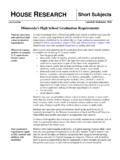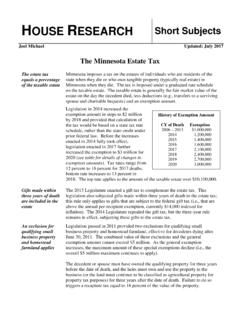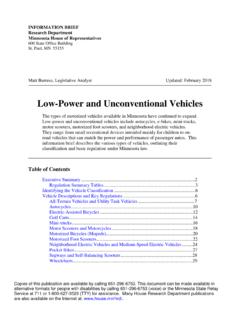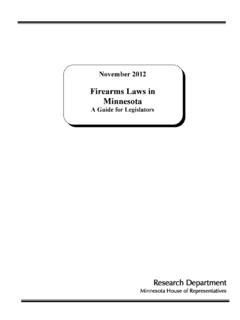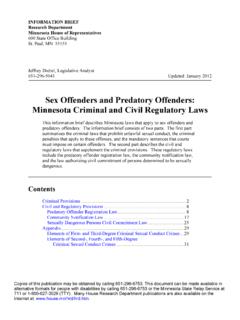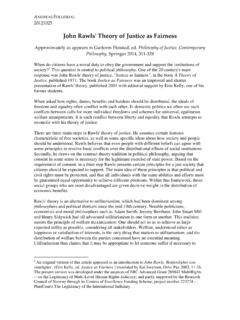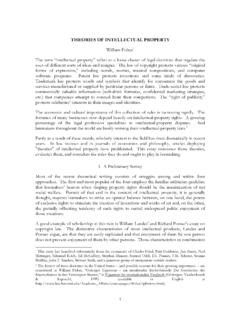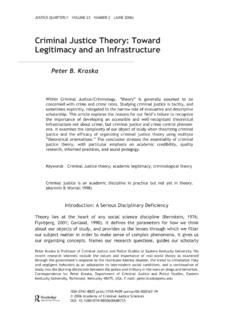Transcription of Do Criminal Laws Deter Crime? Deterrence Theory in ...
1 Do Criminal Laws Deter Crime? Deterrence Theory in Criminal justice Policy: A Primer About this Publication This publication discusses the Theory of Criminal Deterrence as a factor in changing Criminal justice policy. By Ben Johnson, Legislative Analyst January 2019 Contents Executive Summary .. 1 Introduction .. 2 The Economic Model of Deterrence .. 3 Broad Policy Changes and Declining National Crime Rates .. 8 Natural Experiments .. 12 Policy Considerations .. 16 Using Deterrence Theory to Develop Policy .. 17 Questions to Ask When Assessing Policy .. 18 Conclusion .. 18 This publication was prepared by Ben Johnson, a legislative analyst specializing in the area of Criminal justice policy.
2 Questions can be addressed to Ben at 651-296-8957. Minnesota House Research Department provides nonpartisan legislative, legal, and information services to the Minnesota House of Representatives. This document can be made available in alternative formats. | 651-296-6753 | 600 State Office Building | St. Paul, MN 55155 Deterrence Theory in Criminal justice Policy Minnesota House Research Department Page 1 Executive Summary This publication discusses Criminal Deterrence , which is one Theory legislators can use to assess possible changes in Criminal justice policy. When legislators consider changes to Criminal justice policy, they often face the question of whether the changes will prevent people from committing crimes.
3 Legislators in Minnesota may look to other states to see if changes there produced any noticeable effect, but that information may not always present a complete picture. Another tool for legislators is Deterrence Theory . Deterrence Theory was first described in the late 1700s, but received new attention in the 1960s. Academic studies since then have looked at the relationship between the severity of punishment, the certainty that a Criminal will be punished, and the speed with which the punishment will be inflicted. Looking at both long-term trends and smaller case studies, research has shed light on behaviors that can be deterred most easily, policy changes that have little deterrent effect, and the types of actions that are most likely to prevent people from committing crimes.
4 For example, research has shown that: crimes involving conscious planning can be more easily deterred than those that relate toaddiction or sudden emotions; increases to prison sentences that are already lengthy have little deterrent effect; and policies that increase the likelihood of being caught Deter crime more effectively than thosethat increase Theory can help legislators craft and assess policy proposals. Deterrence Theory in Criminal justice Policy Minnesota House Research Department Page 2 Introduction Among the many objects to which a wise and free people find it necessary to direct their attention, that of providing for their SAFETY seems to be the first.
5 1 John Jay, Federalist Papers One of the primary responsibilities of a government is to protect its citizens from crime, but preventing crime can take many forms. There is evidence that crime is disproportionately concentrated in economically distressed areas and that reducing poverty can also reduce Addressing mental illness can also lower crime There is an undisputed link between addiction and crime, and providing chemical dependency treatment is particularly effective at reducing property crime The most common method of addressing crime, though, is through enforcement and punishment. The government identifies actions it wants to prohibit assault, selling drugs, driving while intoxicated, speeding and establishes a consequence for people who take those actions.
6 Consequences exist for several reasons: they punish dangerous behavior, require some form of repayment to society, incapacitate individuals who are seen as likely to commit other offenses, and send the message that society has certain values, morals, or expectations. Several theories of public safety support these policy methods of enforcing laws and punishing offenders. The Theory of incapacitation suggests that holding certain individuals in jail or prison will prevent those individuals from committing new crimes. Rehabilitation theories suggest that directing offenders to certain treatment or training programs will change that individual and keep him or her from committing new offenses.
7 Retributive theories suggest that a person who makes an intentional decision to violate the law should be punished for that decision so that the person can pay a debt to society and then return with a blank slate. Denunciation Theory combines several other theories and holds that punishing someone publicly will prevent others from committing the offense due to the stigma of the offense, and will also serve as a form of retribution. Each of those theories can support Criminal justice policies and serve as a valid lens through which to view policies. But legislators often identify another reason to justify changes to Criminal law Deterrence .
8 Deterrence is the Theory that Criminal penalties do not just punish violators, but also discourage other people from committing similar offenses. Many people point to the need to Deter Criminal actions after a high-profile incident in which an offender is seen to have received a light sentence. Some argue that a tougher sentence would have prevented the tragedy and can prevent a similar tragedy from taking place in the future. But does the creation of a new crime, or the increase in an existing penalty, Deter people from committing crimes? The answer is complex. Legislators seeking to prevent or reduce crime through enforcement and punishment have a variety of policy options to consider.
9 Over the last fifty years, academic studies have examined different techniques from a variety of angles. Legislators may choose to draw on this information to craft effective policies, or assess the likely deterrent effect of proposed legislation. This publication focuses on the Theory of general Deterrence by explaining the theoretical basis of Deterrence Theory , reviewing academic studies, and providing a summary of what legislators can consider if Deterrence is a goal. Deterrence Theory in Criminal justice Policy Minnesota House Research Department Page 3 The Economic Model of Deterrence The first objective is to prevent all sorts of offences as far as this is worthwhile; therefore, the value of the punishment must always be sufficient to outweigh the value of the profit of the offence.
10 5 Jeremy Bentham, 18th century philosopher The Historical Roots of Deterrence Theory The roots of modern Deterrence Theory stretch to the time when the United States was coming into existence. An Italian philosopher and economist, Ceasare Beccaria, wrote Essay on Crimes and Punishments in 1764 and Jeremy Bentham, the English philosopher and reformer, wrote An Introduction to the Principles of Morals and Legislation (introduction to the Principles) in Beccaria wrote that laws exist to allow a united society, free from the threat of war and chaos. He assumed that each individual member of this society will always endeavor to take away from the mass, not only his own portion, but to encroach on that of others.

